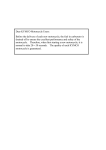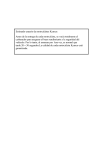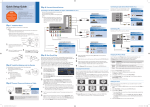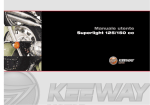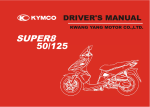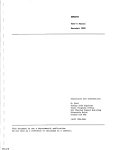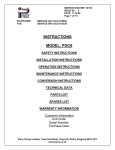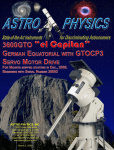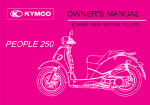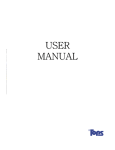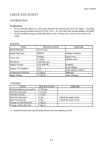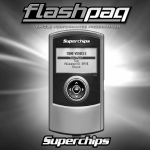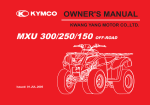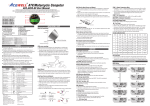Download Dear KYMCO Motorcycle Users: Before the delivery of each new
Transcript
Dear KYMCO Motorcycle Users: Before the delivery of each new motorcycle, the fuel in carburetor is drained off to ensure the excellent performance and safety of the motorcycle. Therefore, when first starting a new motorcycle, it is normal to take 20~30 seconds. The quality of each KYMCO motorcycle is guaranteed. Dear Users: We greatly appreciate your patronage of KYMCO STRYKER 125/150 This User‘s Manual describes the correct operating methods, inspection and maintenance procedures for the KYMCO STRYKER 125/150 details in order to prolong the service life of motorcycle and provide you with a comfortable riding. Please note that the information and illustrations included in this manual may be different from the motorcycle in case specifications are changed. To enable you to have a safe and comfortable riding, we recommend you to read this manual carefully and wish you a happy riding. Note: 1. The information and specifications stated in this manual are for reference only and subject to change without notice. 2. When starting the engine, the battery must be installed to facilitate starting and increase the engine performance. TABLE OF CONTENTS 1. PRECAUTIONS FOR A SAFE RIDING................................................................. 1 2. ASSEMBLY PARTS................................................................................................... 3 3. OPERATION INSTRUCTIONS............................................................................... 5 4. PRE-RIDE INSPECTION....................................................................................... 10 5. ENGINE STARTING METHODS ......................................................................... 19 6. NORMAL RIDING METHOD............................................................................... 22 7. PRECAUTIONS FOR RIDING ............................................................................. 24 8. HOW TO STOP RIDING ........................................................................................ 27 9. EASY MAINTENANCE.......................................................................................... 29 10. IMPORTANT NOTICES ........................................................................................ 36 1. PRECAUTIONS FOR A SAFE RIDING (1) CLOTHES y To relax and wear comfortable clothes are the main points for a safe riding. y To observe traffic laws, keep a cool mind, relax and be careful will provide you a safe riding. cWear helmet and fasten it tightly. dHave the clothes well-arranged. Fasten shirt cuffs and keep them from hooking the brake lever. eWear low-heeled shoes for a safe riding. fWhen riding, use both hands to grasp the handlebar. It is very dangerous to hold the handlebar with one hand. n CAUTION: y A motorcycle rider should not wear loose or too long clothes to avoid danger. y During riding or 10 minutes after the motorcycle is stopped, do not touch the exhaust muffler to avoid scalding. y When parking the motorcycle, keep it away from dry lawn or inflammables to avoid danger. -1- d f c e (2) RIDING METHOD y The safety of two-wheel vehicles is influenced by sitting position. The rider should sit on the central part of the seat cushion. If the rider sits on the rear part of the seat, the load of front wheel will decrease. As a result, the handlebar will swing and cause danger to the rider. y When making a turn, it will be easier for the rider to steer the motorcycle by leaning the body inward slightly. The motorcycle will lose its balance if the rider fails to keep his body leaning inward. y When riding on a damaged or macadam road. Slow down the speed and hold the handlebar tightly. (3) CARRYING GOODS y Keep a good sitting posture to operate the motorcycle properly. y The feel of the handlebar will be different when carrying goods on the motorcycle. Overloading may cause the handlebar to swing. Avoid riding with overload. c Max. loading capacity of the rear carrier is 3kg. -2- c 2. ASSEMBLY PARTS Turn Signal Switch Headlight Dimmer Switch Fuel Tank Cap L. Front Turn Signal Light Taillight/ Stoplight VIN (Vehicle Identification No.) L. Rear Turn Signal Light Engine Serial No. Tool Boxp Side Support Clutch panel -3- Ignition Switch Instruments Starter Button R. Front Turn Signal Light R. Rear Turn Signal Light Exhaust Pipe Frame Serial No. Kick Lever Rear Brake Lever -4- 3. OPERATION INSTRUCTIONS (1) IGNITION SWITCH/STEERING HANDLEBAR LOCK c ON :At this position, power is connected to start the engine. The key cannot be taken out. d OFF :At this position, power is cut off and the engine stops. The key can be taken out. e LOCK :At this position, the steering handlebar is locked. The key can be taken out 《Locking Method》 Turn the steering handlebar left to the full and then press to turn the ignition switch key to “LOCK” position and the handlebar is locked. 《Unlocking Method》 Turn the key to “OFF” and the lock is released automatically. n CAUTION: y After locking, turn the handlebar gently to make sure that it is locked. y Do not turn the ignition switch to “LOCK” during riding, or the handlebar will be out of control and cause accidents. y Don‘t park your motorcycle at a place to hinder the traffic. -5- c d e (2) STARTER BUTTON y Release the steering handlebar lock before starting the engine. Turn on the ignition switch and then press the starter button. Make sure to depress the gear shift pedal into the neutral position to avoid engine damage. n CAUTION: y During engine running, do not push the starter button to avoid engine damage. y Before starting the engine, please rebound the side stand. (3) HEADLIGHT SWITCH/ HORN BUTTON z At this position, the position light, headlight, instrument lights and taillight go out together. P At this position, the position light, instrument lights and taillight light together. H At this position, the position light, headlight, instrument lights and taillight light together. y When the ignition switch is turned “ON”, press the horn button and the horn will sound. y The horn switch do not work when the ignition switch is “OFF”. y -6- (4) HEADLIGHT DIMMER SWITCH/ PASSING SIGNAL SWITCH HI LO Switch to this position for using high beam. When riding in downtown area or there is a car coming from the opposite direction, use low beam to avoid affecting the visibility of coming cars. PASSING When passing, if there are cars coming from the opposite direction, press and release the PASSING switch and the PASSING headlight will wink to warn the coming cars. (5) TURN SIGNAL SWITCH y The turn signal switch do not work when the ignition switch is “OFF”. y When the winker lamp is used, both the winker lamp on the panel will blink same time. cÖ For turning to the right. dÕ For turning to the left. e Push the turn signal switch button to release it. d c e n CAUTION: y The turn signal light will not release automatically. Be sure to reset it after use; otherwise it may affect the traffic safety. -7- (6) TOOL BOX y The tools in box are attached to this motorbike and you can put what you need in the rest space ,too. c c Max. loading capacity of the tool box is 1.5kg. (7) HELMET BUCKLE LOCK y Insert the main switch key and turn it counterclockwise. Then,put in the helmet buckle and push the lock latch left to lock it. y When taking out the helmet,insert the key and turn it counterclockwise to open the lock. n CAUTION: y When riding, wear the helmet and do not retain it on the motorcycle to avoid damage of coated parts. -8- Lock Open (8) INSTRUMENTS c MILEAGE COUNTER: The total riding mileage is indicated by kilometer. The figure in black and white is an unit of 100m. d NEUTRAL POSITION INDICATOR LIGHT: When the engine is at the neutral position, this indicator light will come on when the ignition switch is ON. e SPEEDOMETER: The riding speed is indicated by km/hour. f TURN SIGNAL INDICATOR LIGHT: When the turn signal switch is operated, this indicator light will wink. g HIGH BEAM INDICATOR LIGHT: This indicator light comes on when the long distance light is turned on. h FUEL GAUGE: The fuel gauge is to show the volume of gasoline in the fuel tank. If the fuel gauge pointer is at the red area, the fuel is insufficient. Refill 92# or 95# nonleaded gasoline as early as possible. i TACHOMETER: It indicates the engine revolution per minute. (Do not idle the engine at high speed or run the engine in the red area of the tachometer frequently. This will seriously affect the engine service life.) -9- g f d fc i h e 4. PRE-RIDE INSPECTION (1) ADVANCE INSPECTION y Get into a good habit of inspection before riding. For the sake of safety and to prevent vehicle damage and traffic accidents, the pre-ride inspection is absolutely required. n CAUTION: y Be sure to perform inspection and maintenance for your new motorcycle after it is purchased for one month or ridden for 300km. (2) ENGINE OIL LEVEL INSPECTION/ REFILLING y Check through the sighthole if the oil level is between the upper limit and lower limit. y If the oil level is below the lower limit,add the engine oil to the upper limit. n CAUTION: y The oil level will be incorrect if the motorcycle is just y Be careful to avoid burns if oil level checkor oil change is performed immediately after the engine is stopped. - 10 - Upper Limit Lower Limit (3) BRAKE INSPECTION y Ride the motorcycle at low speed on a dry road and respectively apply the front and rear brakes to check the brake performance. y The brake lever should have proper free play. y “Free play” means the distance from the position of loose brake to the position of fully applied brake. y Measure the free play at the brake lever end and check if it is within the specified value of (2~ 3cm rear brake). (4) TIRE INSPECTION 1. Tire Pressure Check y Check if the tire pressure is normal when the tire is in contact with level ground. y If there is any abnormal condition, check the tire pressure with a tire pressure gauge. y Measure the tire pressure under room temperature. - 11 - Rear Brake 2. CRACKS & DAMAGE y Check the tire-contact area for crack or damage. 3. Abnormal Wear y Check the tire-contact area for abnormal wear. 4. FOREIGN OBJECTS OF METAL PIECE & GRAVEL y Check the tires and tire-contact area for imbedded objects of metal piece and gravel. 5. DEPTH OF TIRE GROOVE y If the tire is worn to the wear limit indication mark, replace it with a new one. NORMAL PRESSURE(1 Rider / 2 Riders ) Front Wheel 1.75/2.00 kg/cm² Rear Wheel 1.75/2.25 kg/cm² n CAUTION: y Abnormal tire pressure, crack, damage and abnormal wear will cause unsteady handlebar and result in tire break. y If the tire has cracks or is worn to the wear limit indication mark, replace it with a new one. - 12 - (5) FUEL LEVEL INSPECTION/REFILLING y Check if the fuel is sufficient. y If the fuel gauge pointer is at “E” (red line), refill #92 or #95 nonleaded gasoline as soon as possible. 《Refilling Method》 1. Open the fuel tank cap protective cover. Insert the ignition switch key into the fuel tank cap lock and turn the key counterclockwise to unlock and open the cap. 2. Use #92 or #95 nonleaded gasoline to fill the fuel tank. 3. When closing the cap, install the fuel tank cap by aligning the tab on the cap with the groove on the fuel filler. 4. When closing, simply pres down the fuel tank cap to close it. cFuel tank cap protective cover dUnlock eLock fReference plate n CAUTION: y Be sure to stop the engine before refilling. y The gasoline level shall not exceed the reference plate; otherwise the fuel will penetrate out. y When refilling, do not add other additives to avoid engine breakdown. - 13 - c d f e (6) STEERING HANDLEBAR y Visually inspect the steering handlebar for damage. y Apply the front brake and move the handlebar upward and downward to check for abnormal noise. y Move the steering handlebar upward, downward, rightward and leftward to check for any loose parts. y Check if the handlebar rotates freely. y If any abnormal condition is found, go to your motorcycle dealer or for inspection. (7) INSTRUMENT LIGHTS INSPECTION y Check the speedometer pointer for proper operation. y Check the fuel gauge pointer for proper operation. y Check the turn signal indicator lights and high beam indicator light for proper operation. - 14 - (8) BRAKE LEVER FREE PLAY INSPECTION & ADJUSTMENT y Adjust the brake lever free play with the brake adjusting nuts. y After adjustment, fully apply the brake levers and check if the free play is within the specified value (lever1~2cm). c Increase play d Decrease play n CAUTION: y After the brake is adjusted, align the groove of adjusting nut with the pin in order to avoid accident and danger during riding. (9) BRAKE SHOE INSPECTION y When the brake lever is fully applied, if the mark “△” on the brake indicator aligns with the reference mark “△” on the brake panel, it means the brake shoe is worn out. Go to our designated distributors or service stations for brake shoe replacing. y Brake shoe service limit: cFront n CAUTION: y Brake shoe will be worn more quickly if the brake lever is always applied lightly during riding. - 15 - d c c (10) HORN/LIGHTS INSPECTION y Turn the ignition switch “ON” and press the horn button to check if it sounds. y Headlight/Taillight Inspection: Start the engine and turn on the headlight switch to check if the headlight and taillight are good and check the light shells for dirt and damage. y Stoplight Inspection: Apply the front and rear brake levers respectively to check if the stoplight is good. And also check the stoplight shell for dirt and damage. y Turn Signal Light Inspection: Operate the turn signal switch to make sure whether the right/left front and rear turn signal lights can wink and buzz. Also check the light shells for dirt and damage. c Headlight d Turn signal light e Taillight/ Stoplight f Horn button n CAUTION: y Replace any dirty or damaged lights with new ones to avoid danger during riding. - 16 - c d f e (11) CLUTCH LEVER FREE PLAY INSPECTION y The clutch lever free play shall be 1~2cm. Often check the clutch lever free play and make necessary adjustment by turning the adjusting nut. cFree Play 1~2cm dLock Nut eAdjusting Nut n CAUTION: y If the clutch lever free play is too big or small, the clutch disk will be damaged easily. ` (12) DRIVE CHAIN INSPECTION/ ADJUSTMENT y The chain should have a slack of 1~2cm in its center between the two sprockets. y Adjustment: Loosen the rear axle nut and turn the adjusting nut until the index mark is aligned with the punch mark on the adjuster. Then tighten the rear axle nut. cRear Axle Nut dAn Amplitude Modulator e1~2cm y The rear wheel will move backward during adjustment, so the rear brake free play shall also be adjusted. - 17 - d c e d c e (13) FRONT/REAR SHOCK ABSORBER INSPECTION y Check the condition of the front/rear shock absorbers by pressing down on the handlebar and seat several times. (14) BRAKE PERFORMANCE INSPECTION y Fully apply the front and rear brake levers and move the motorcycle forward to see if the braking effect is good. (15) REARVIEW MIRROR ANGLE CHECK y Sit on the motorcycle upright and make a viewing test of the rearview mirror angle. (16) LICENSE PLATE CHECK y Check the license plate for dirt and damage, then tighten it. (17) REFLECTOR CHECK y Check the reflector for dirt and damage. (18) PREVIOUS ABNORMAL PARTS INSPECTION y Make sure that the previous abnormal parts are repaired. (19) LUBRICATION POINT CHECK y Visually check if all motorcycle lubrication points are lubricated properly. - 18 - 5. ENGINE STARTING METHODS (1) TURN THE IGNITION SWITCH “ON” y Unlock the steering handlebar. y Before starting the engine, please rebound the side stand. c Safety Installation. n CAUTION: y Check the gasoline volume and engine oil level before starting the engine. (2) USE NEUTRAL POSITION y The engine must be started in the neutral position. When the ignition is ON, the neutral position indicator light comes on. n CAUTION: y Shift into a proper speed for riding. y When changing speed, the throttle grip must be turned to the closed position. Then, fully apply the clutch lever and gently depress the gear shift pedal. - 19 - c (3) USE THE STARTER BUTTON y Push the starter button without rotating the throttle grip. y If the engine fails to start after the starter button is pressed for 3~4 seconds when it is warm, rotate the throttle grip for 1/8~1/4 turn to facilitate starting. y When the motorcycle is not used for a long time or the fuel tank is empty, if the engine is still hard to start after the fuel tank is refilled with gasoline, slightly turn the throttle grip and press the starter button for several times to start the engine. y In order to avoid battery overcharge, do not press the starter button more than 5 seconds. y If the engine does not start after the starter button is pressed for 5 seconds, wait for more than 5 seconds and then press the button again or start the engine by the kick lever. n CAUTION: y Don‘t press the starter button while the engine is running; otherwise the engine will be damaged. - 20 - (4) START WITH THE KICK LEVER 1. Place the motorcycle on its main stand on level ground. 2. Depress the kick lever with force. y When the engine is cold and does not start after the kick lever is depressed for 3~4 times, rotate the throttle grip for 1/8~1/4 turn to facilitate starting. y Warm up the engine for a little while (about 2~3 minutes) after cold start. y After the engine is started, do not accelerate suddenly and keep riding at low speed to prolong the engine service life. n CAUTION: y After the engine is started, the kick lever must be returned to its original position. y The exhaust contains poisonous carbon monoxide which is harmful to human body. Never run the engine in a closed area. y Turn off all light switches before starting the motorcycle. - 21 - 6. NORMAL RIDING METHOD (1) REBOUND THE SIDE STAND y Keep the engine in the neutral position and support the motorcycle upright, then the side stand will rebound automatically. n CAUTION: y After starting the engine and before moving, do not turn the throttle grip to increase the engine rpm. (2) STARTING THE ENGINE y Start the engine by referring to the starting methods specified in Section 5. n CAUTION: y Keep your finger away from the button immediately after the engine is started to avoid engine damage. y The engine must be kept in the neutral position before riding. - 22 - (3) CORRECT SITTING POSITION y Ride astride on the motorcycle from the left side and sit upright. Touch the ground with left foot to avoid slipping. n CAUTION: y The rider must wear helmet and fasten the safety belt securely. y Do not wear any loose clothes which will affect riding safety. (4) START MOVING 1. Fully apply the clutch lever and depress the gear shift pedal into the 1st speed with the left foot. 2. Slowly rotate the throttle grip and release the clutch lever at the same time. Then the motorcycle will move smoothly. n CAUTION: y When changing speed, the throttle grip must be turned to the closed position. Then, fully apply the clutch lever and gently depress the gear shift pedal. - 23 - 7. PRECAUTIONS FOR RIDING (1) CORRECT RIDING y Before moving, turn on the turn signal light and make sure whether the rear side is safe. y Do not rush into the car lanes and always keep the motorcycle to the right to avoid danger. n CAUTION: y Moderate riding will prolong the engine service life. The clutch linings are worn more quickly when often ridden at low speed. (2) SPEED CONTROL y The speed is controlled by the throttle grip. c ROTATE The speed will become faster. Don‘t be hasty and accelerate slowly. When riding on an ascending road, rotate the throttle grip gradually to increase the horse power. d RESTORE The speed will become slower. Restore the throttle grip quickly. n CAUTION: y Apply the brake while restoring the throttle grip. This will shorten the time required to slow down. - 24 - c d (3) PROPER RIDING WILL PROLONG THE SERVICE LIFE OF ENGINE y For a new motorcycle, keep the speed below 60km per hour within the first 1000km of riding. y Avoid sudden acceleration and long-time riding at high speed. y In hot weather, the engine overheats easily at long-time idling. Stop the engine in this case. n CAUTION: y Moderate riding will prolong the engine service life. (4) APPLY BOTH FRONT AND REAR BRAKES WHEN BRAKING y First restore the throttle grip to the closed position and then pull the brake levers tight. y The best way to brake the motorcycle is to pull the brake levers “slowly” at the very beginning, then pull them tight. n CAUTION: y Apply single brake lever will cause the motorcycle to slip. y During riding, never brake the motorcycle suddenly. It may cause the motorcycle to slip and could be very dangerous. - 25 - (5) DO NOT MAKE SUDDEN STOP OR SHARP TURN y Sudden stop and sharp turn are the main causes for slipping and could be very dangerous. y In rainy days the road is slippery. Sudden stop will cause the motorcycle to slip. Be careful to avoid danger. (6) BE MORE CAREFUL WHILE RIDING IN RAINY DAYS y A longer braking distance is required in rainy days than in sunny days. Be sure to slow down and brake the motorcycle slowly as early as possible. y When riding on a descending road, restore the throttle grip to closed position and slow down by making intermittent braking. n CAUTION: y A longer braking distance is required in rainy days. Be sure to slow down and brake the motorcycle slowly as early as possible. - 26 - 8. HOW TO STOP RIDING (1) WHILE GO NEAR THE PARKING PLACE y Turn on the turn signal light in advance. Watch out vehicles coming behind or aside and stop the motorcycle to the right side slowly. y Restore the throttle grip to closed position and apply the front and rear brakes as early as possible. y At this moment, the stoplight will come on to warn the vehicles coming behind. (2) WHILE THE MOTORCYCLE IS COMPLETELY STOPPED y Return the turn signal switch to its original position. y Turn the ignition switch “OFF” to stop the engine. n CAUTION: y During riding, never operate the ignition switch key. y When the ignition switch is turned “OFF”, the electric system does not work which may result in traffic accident. Operate the switch key after the motorcycle is fully stopped. - 27 - (3) PARKING y Place the motorcycle on its main stand on level ground and do not hinder the traffic. y Stand on the left side and grip the handlebar straight with left hand and the side rod or rear carrier with right hand. Then, put down the side stand by your right foot. n CAUTION: y The motorcycle may easily fall down if it is parked on an uneven ground. (4) HANDLEBAR y After parking, be sure to lock the steering handlebar and take out the key to prevent pilferage. (Refer to P5.) n CAUTION: y Don‘t park your motorcycle at a place to hinder the traffic. y The temperature of engine and exhaust muffler is very high. Be careful to avoid scalding. y Park the motorcycle at a safe place and be sure to take out the key to prevent pilferage. - 28 - 9. EASY MAINTENANCE (1) AIR CLEANER INSPECTION AND AIR CLEANER CLEANING & REPLACEMENT y Take out the air cleaner and visually check if it is dirty or clogged. 1. Remove the screws attaching the air cleaner cover and remove the air cleaner cover. 2. Remove the air cleaner element. 3. The installation sequence is the reverse of removal. y Clean the air cleaner element with compressed air. y Replace the air cleaner element at very 3000km. y The air cleaner requires more frequent cleaning or replacing when ridden in unusually dusty areas. When replacing, refer to P37 Periodic Inspection & Maintenance Schedule. n CAUTION: y Never use oil or solvent to wash the wet type paper element. y Be careful not to allow water to enter the air cleaner; otherwise, it may result in hard starting. y If the air cleaner is not installed properly, dust may be sucked into the cylinder directly to reduce engine horsepower and affect the service life of engine. - 29 - (1) (2) (2) FUEL SYSTEM y Fuel Leakage Inspection Check the fuel line between the fuel tank and carburetor for fuel leakage. cFuel tube connector dFuel tank n CAUTION: y Check and replace any broken or damaged tube connector to avoid breakdown due to running out of gasoline. (3) APPEARANCE CLEANING y Often wipe clean the motorcycle appearance to prevent accumulated dust affecting the function of components. n CAUTION: y If a motorcycle is not used for a long time, check the operation of each part and replace lubricants before riding. Ride the motorcycle only after its performance is confirmed. y When waxing the motorcycle, make sure that the ingredients of the wax will not damage the paint of the motorcycle. - 30 - d c (4) BATTERY y This model adopts the battery which needs no refilling of distilled water. y When cleaning the terminal terminals, remove the screws attaching the battery cover on the floor board and then open the battery cover. y When battery terminals are corroded, take out the battery for cleaning. y After cleaning, apply a thin coat of grease or Vaseline to battery terminals and then install the battery. n CAUTION: y Never open the closed-type battery electrolyte cap. y If the motorcycle will not be used for a long time, the battery will discharge electricity by itself. Remove the battery and put it in a cool place after it is fully charged to prevent electricity leakage. y If the motorcycle will not be used for a long time, remove the negative (-) terminal. y Do not smoke or allow flames or sparks near the battery while removing and installing it. y Turn off the ignition switch before removal or installation. The negative (-) terminal shall be removed first and the positive (+) terminal shall be installed first. y Tighten the loose terminal nuts securely. - 31 - Battery (5) FUSE CHANGE y Turn off the main switch and check if the fuse is burned out. y When the fuse is burned out, replace with a specified fuse. y Check for the cause of breakdown before replacing. y Fuse Specification: 15A Fuse n CAUTION: y Be careful not to excessively expand the fuse clip during removal. y After a new fuse is installed, check the fuse clip for looseness which is the main cause of trouble. y Never use fuse of unspecified capacity, it may cause wire overheating and burning out. y When replacing electric appliances (lights, instruments), be sure to use the recommended genuine parts. y When washing the motorcycle, avoid flushing it. y If the cause can not be found, contact our distributor or service station for inspection. - 32 - (6) ENGINE OIL CHANGE 1. Place the motorcycle on its main stand on level ground. 2. Remove the oil dipstick. 3. Remove the drain bolt to drain the oil. 4. Refill fresh engine oil for 0.9 liter. Firmly tighten the oil dipstick. 5. Warm up the engine and check the oil level again after the engine is stopped for 20~30 seconds. y Specified Oil: SAE 15W40# cDrain Screw dOil Strainer n CAUTION: y When changing the engine oil, also clean the oil strainer and reinstall it. y Use the specified engine oil. y Change engine oil at first 300km and then change it at every 2000km. y Engine oil will deteriorate easily and require more frequent change if the motorcycle is often ridden in dusty and cold areas or ridden for short distance. y Do not mix engine oil of different classes or viscosities. It may cause damage to engine. - 33 - c d Decrease Play Increase Play (7) SPARK PLUG INSPECTION y Check the spark plug side electrodes for wear. y Fouling deposits on spark plug electrodes and big gap may result in weak spark. y Spark Plug Removal: 1. Remove the spark plug with a spark plug remover. 2. The installation sequence is the reverse of removal. y Spark Plug Cleaning: 1. It is better to remove spark plug deposits with a spark plug cleaner. 2. If a spark plug cleaner is not available, clean with a wire brush. y The side electrode gap is 0.6~0.7mm. y Specified Spark Plug: NGK-DR8EA cDeformation dCracks, Damage eGap, Wear, Fouling Deposits n CAUTION: y Clean the spark plug at every 1000km and replace it with a new one at every 5000km or when the center electrode is burned out. y First screw in the spark plug with fingers and then tighten with a spark plug wrench. y Use unspecified spark plug may damage the engine. - 34 - Spark c d e (8) BRAKE FLUID LEVEL INSPECTION /REFILLING y Remove the 2 screws from the brake fluid tank and take off the cover. y Add recommended brake fluid DOT-3 into the tank until the fluid level reaches the upper limit and then put on the cover and tighten the screws. y Recommended Brake Fluid: DOT-3 n CAUTION: y Do not mix brake fluid of different brands. It may cause brake failure and is very dangerous. When refilling brake fluid, use towels to cover and protect the painted and coated surfaces. (Replace at 10000km or every year.) (9) RUBBER COVER INSPECTION FOR WIRE AND CABLE y The cable cores are protected by the rubber cover outside the connector. Check the rubber cover frequently for proper installation. y When washing the motorcycle, do not flush the rubber cover directly or brush it. Use a wet rag to wipe off dirt and dust. cRubber Cover dCheck Points - 35 - d c 10. IMPORTANT NOTICES (1) WHEN THE ENGINE FAILS TO START OR STOPS DURING RIDING y Is the gasoline enough? y If the fuel gauge pointer is at the red line, refill #92 or #95 nonleaded gasoline. y Is the way to start the engine correct? y Is there any other faulty parts? (2) IN CASE OF BREAKDOWN y For any trouble occurred during riding, go to a KYMCO distributor or service station for inspection. n CAUTION: y For the sake of safety and to prevent vehicle damage and save your precious time, the pre-ride inspection is absolutely required. Please read this User’s Manual carefully and get into a good habit of inspection before riding. - 36 - (3) POLLUTION-FREE PERIODIC MAINTENANCE SCHEDULE y In order to have a safe riding, maintain good performance, prolong the motorcycle service life and reduce pollution, make sure to perform the periodic inspection and maintenance. I: Inspect and clean, lubricate, refill, repair or replace if necessary. A: Adjust C: Clean R: Replace T: Tighten Item 9 9 9 9 9 9 9 9 9 9 9 9 9 9 9 9 Engine Oil Engine Oil Strainer Gear Oil Cooling Water Spark Plug Valve Clearance Carburetor Drive Belt Drive Chain Air Cleaner Battery Electrolyte Fuel Filter Screen Brake System Clutch Lever Free Play Bolts & Nuts Tire Pressure Motor Oil Strainer Engine Oil Pump 9 2Stroke 4Stroke × × ○ ○ ○ × × ○ ○ ○ ○ ○ ○ ○ ○ ○ ○ ○ ○ ○ ○ ○ ○ ○ ○ ○ ○ ○ ○ ○ ○ ○ ○ ○ × × Regular Service Mileage (KM) Daily Pre-ride 1000 3000 5000 7000 9000 11000 Inspection R R R R R R I C C C R R R Clean at every 10000 km or once a year. I Clean ( C ) at every 3000km or replace ( R ) if necessary. A A A A I I I I A A A A A A I R I R I R I I I I I I I R I I I I I I I A A A A A A T T T I I I I I I I C I I I I 300 R C R y The above items are applicable to different models. Perform suitable items for each model. y When exceeding the listed mileages, perform maintenance according to the listed intervals. y The air cleaner requires more frequent cleaning or replacing when ridden in unusually dusty areas. - 37 - (4) EXPLAINATION FOR ACTION OF SAFETY INSTALLATION 1.MOTOR CAN BE STARTED WHILE ENGINE IS IN NEUTRAL POSITION. - 38 - 2.MOTOR CAN BE STARTED WHILE SIDESTAND SWITCH IS BEING KIKED ON AND CLUTCH SWITCH IS ACTING - 39 - 3.CDI CAN BE STARTED WIHLE ENGINE IS IN NEUTRAL POSITION - 40 - 4.CDI CAN BE STARTED WHILE SIDE STAND SWITCH IS BEING KIKED ON - 41 - (5) SPECIFICATIONS ( DA25AA . DA25AB ) OHC air ooled 4stroke single cylinder Displacement 124 cc Bore x Stroke 56.5x49.5 mm Compression Ratio 9.2 : 1 Max. Output 8.8/9000 kw/min Engine Type Max. Torque Transmission Type Idle Speed Clutch Ignition Starting System Spark Plug 9.5/7000 N.m(r/min) Overall Length 2120 mm Overall Width Overall Height Dry Weight Wheel Base 880 mm 1300 mm 127 kg 1390 mm Tire Size F:90/90-21(OFF Road) 3.0-18(ON Road) R:130/80-17 Left foot operated gear #92 or 95 nonleaded Fuel Type shift pedal gasoline 1600 rpm Oil Tank Capacity 1.0 liter Wet multi-disc clutch Fuel Tank Capacity 12 liter C.D.I. Engine Oil Type 15W-40# Starting motor and Fuse 15A kick starter Battery 12V6AH NGK−DR8EA - 42 - ( DA30AA . DA30AB ) OHC air cooled 4stroke single cylinder Displacement 149.4 cc Bore x Stroke 62x49.5 mm Compression Ratio 9.7 : 1 Max. Output 9.5/9000 kw/min Engine Type Max. Torque Transmission Type Idle Speed Clutch Ignition Starting System Spark Plug 11.37/7000N.m/(r/min) Overall Length 2120 mm Overall Width Overall Height Dry Weight Wheel Base 880 mm 1300 mm 127 kg 1390 mm Tire Size F:90/90-21(OFF Road) 3.0-18(ON Road) R:130/80-17 #92 or 95 nonleaded Left foot operated gear Fuel Type shift pedal gasoline 1600 rpm Oil Tank Capacity 1.0 liter Wet multi-disc clutch Fuel Tank Capacity 12 liter C.D.I. Engine Oil Type 15W-40# Starting motor and Fuse 15A kick starter Battery 12V6AH NGK−DR8EA - 43 -














































